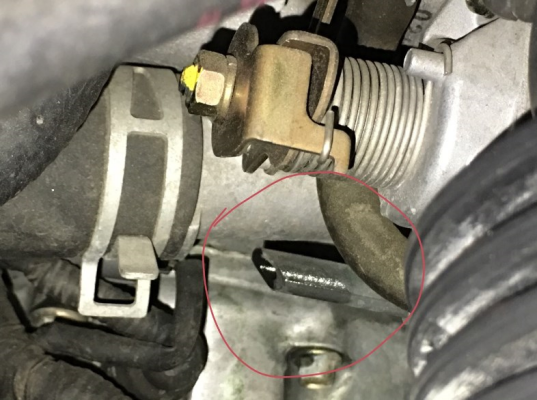A faulty or malfunctioning throttle position sensor (TPS) can disrupt the smooth operation of a vehicle's engine and affect its performance. Here are some common reasons why a throttle position sensor may not be working correctly:

-
Wear and Tear: Over time, TPS components can wear out due to regular use, exposure to heat, and engine vibrations. This wear can lead to inaccurate readings or failure of the sensor.
-
Dirty or Contaminated Sensor: Accumulated dirt, oil, or other contaminants on the sensor surface can interfere with its functionality and accuracy. Cleaning the sensor may resolve issues related to contamination.
-
Electrical Issues:
- Poor electrical connections or damaged wiring leading to the TPS can cause signal disruption or loss.
- Corrosion on electrical contacts can also lead to inconsistent TPS readings.
-
Incorrect Installation or Adjustment:
- Improper installation of the TPS or incorrect adjustment of its position can result in inaccurate readings and erratic engine performance.
- Realigning and calibrating the sensor correctly may resolve issues related to installation errors.
-
Mechanical Issues:
- Mechanical damage to the throttle body or associated components can impact TPS function.
- Physical obstructions in the throttle mechanism can prevent the sensor from accurately detecting throttle position.
-
Software or Calibration Errors:
- Incorrect software calibration, settings, or software glitches in the engine control module (ECM) can lead to misinterpretation of TPS signals.
- Recalibrating or reprogramming the ECM may be necessary to correct software-related issues.
-
Faulty Sensor:
- In some cases, the TPS itself may be defective or failed, requiring replacement to restore proper function.
- Testing the TPS with a multimeter or diagnostic tool can help identify if the sensor is functioning correctly.
-
Environmental Factors:
- Extreme temperatures or environmental conditions can affect sensor performance. High heat or cold can impact sensor readings.
If you suspect that your throttle position sensor is not working correctly, it is advisable to have the vehicle diagnosed by a qualified mechanic or automotive technician. They can conduct diagnostic tests, inspect the sensor and related components, and recommend appropriate repairs or replacements to address the issues affecting the TPS functionality. Regular maintenance and prompt attention to sensor-related concerns can help maintain the efficiency and performance of your vehicle's engine.

Can I Test the Throttle Position Sensor
Yes, you can test the throttle position sensor (TPS) to check its functionality and determine if it is working correctly. Here are the steps to test the TPS using a multimeter:
Tools Required:
- Multimeter
- Safety gloves and goggles
- Assistant (optional)
Steps to Test the Throttle Position Sensor:
-
Locate the TPS: The TPS is typically located on the throttle body, attached to the throttle shaft or throttle plate.
-
Disconnect the TPS: Disconnect the electrical connector from the TPS. Refer to the vehicle's service manual for guidance on locating and disconnecting the TPS.
-
Set Multimeter: Set your multimeter to the DC voltage setting. Depending on the vehicle make and model, you may need to set the multimeter range to a suitable voltage level (consult the vehicle manual).
-
Connect Multimeter:
- Connect the black (negative) lead of the multimeter to the ground wire or the vehicle's chassis.
- Connect the red (positive) lead of the multimeter to the signal wire from the TPS. This wire is usually the center wire on the TPS connector.
-
Assistant Assistance (optional): If possible, have an assistant turn the ignition key to the ON position without starting the engine. This will power the TPS for testing.
-
Observe Voltage:
- Slowly press on the gas pedal to move the throttle. As you do this, observe the voltage reading on the multimeter.
- The voltage should increase smoothly and consistently as you open the throttle, without any sudden jumps, drops, or fluctuations.
-
Test at Idle:
- Release the gas pedal to return the throttle to the idle position. The multimeter should now register a stable voltage corresponding to the idle position.
- Ensure that the voltage reading is within the specified range for idle position as outlined in the vehicle's service manual.
-
Test at Wide Open Throttle:
- Depress the gas pedal fully to open the throttle completely. The multimeter should now register the maximum voltage specified for wide-open throttle.
-
Interpret Results:
- If the voltage readings do not change smoothly and consistently as the throttle is opened or closed, or if the voltage readings are outside the specified range, the TPS may be faulty and require replacement.
-
Reconnect TPS: Once testing is complete, reconnect the TPS electrical connector securely.
If the TPS fails the voltage test or shows irregularities in voltage readings, it is advisable to replace the sensor to ensure proper engine performance and responsiveness. If you are unsure about testing the TPS yourself, it is recommended to seek assistance from a qualified mechanic or automotive technician for accurate diagnosis and repairs.

How to Test Throttle Position Sensor
Testing the throttle position sensor (TPS) is an important step in diagnosing potential issues with the sensor or the vehicle's fuel delivery system. Here's a general guide on how you can test the TPS using a multimeter:
Tools Required:
- Multimeter
- Safety gloves and goggles
- Assistant (optional)
Steps to Test the Throttle Position Sensor:
-
Locate the TPS: The TPS is typically mounted on the throttle body, and it is connected to the throttle plate or shaft.
-
Disconnect the TPS: Start by locating the TPS and carefully disconnecting its electrical connector. Refer to your vehicle's service manual for specific instructions on locating and disconnecting the TPS.
-
Setting Up the Multimeter:
- Set your multimeter to the DC voltage setting. Depending on your multimeter, you may need to select an appropriate voltage range (consult the user manual for guidance).
- Attach the multimeter leads: Connect the black (negative) lead to the vehicle's ground wire or a metal surface, and connect the red (positive) lead to the signal wire of the TPS. The signal wire is usually the center wire on the TPS connector.
-
Ignition Key Position:
- Have an assistant turn the ignition key to the ON position without starting the engine. This provides power to the TPS for testing purposes.
-
Testing Procedure:
- Slowly press on the gas pedal to open the throttle. Observe the multimeter reading as you gradually increase the throttle position.
- The voltage should increase smoothly and steadily as you open the throttle. Watch for any erratic jumps, drops, or fluctuations in the voltage reading.
-
Testing at Different Throttle Positions:
- Check the voltage at idle position and wide-open throttle position:
- At idle, the voltage reading should be within the specified range indicated in the vehicle's service manual.
- At wide-open throttle, the voltage should reach the maximum specified value without any irregularities.
- Check the voltage at idle position and wide-open throttle position:
-
Interpreting the Results:
- If the voltage readings do not change smoothly or if they are outside the recommended range, the TPS may be faulty and require replacement.
- Inconsistent voltage readings or voltage spikes can indicate a malfunctioning TPS.
-
Reconnect the TPS: After completing the testing, securely reconnect the TPS electrical connector.
-
Consult a Professional:
- If you are unsure about performing the test or interpreting the results, or if you suspect issues with the TPS, it's recommended to seek assistance from a qualified mechanic or automotive technician for further diagnosis and necessary repairs.
By following these steps and testing the throttle position sensor with a multimeter, you can determine if the TPS is functioning correctly and identify any potential issues affecting the sensor's performance.
How to Fix Throttle Position Sensor Not working
If you have determined that your throttle position sensor (TPS) is not working correctly through testing and diagnostics, there are several steps you can take to address the issue. Here are some common methods to fix a malfunctioning throttle position sensor:
1. Cleaning the Throttle Body and TPS:
- Start by cleaning the throttle body and the TPS to remove any dirt, debris, or carbon buildup that may be affecting sensor performance.
- Use an appropriate throttle body cleaner and a soft brush to clean these components carefully.
2. Check Connections and Wiring:
- Inspect the electrical connections to the TPS for any signs of corrosion, damage, or loose connections. Ensure that the wiring harness is securely connected.
- Repair or replace any damaged wiring and clean the connectors with electrical contact cleaner.
3. Resetting the TPS:
- Some vehicles may require a TPS reset procedure after cleaning or replacing the sensor. Refer to your vehicle's service manual for specific instructions on how to reset the TPS.
4. Recalibration:
- If your vehicle's TPS is adjustable, follow the manufacturer's guidelines for recalibrating the sensor position. This may involve adjusting the sensor to the correct position for optimal performance.
5. Replacing the Throttle Position Sensor:
- If cleaning and recalibrating the TPS do not resolve the issue, you may need to replace the sensor with a new one. Purchase a TPS that is compatible with your vehicle make and model.
- Follow the manufacturer's instructions for proper installation of the new TPS. Ensure that the sensor is correctly positioned and securely attached.
6. Diagnostic Scan:
- Perform a diagnostic scan using an OBD-II scanner to check for any error codes related to the TPS or other components in the engine management system. Address any additional issues that may be affecting TPS performance.
7. Professional Assistance:
- If you are unable to fix the TPS issue on your own or if the problem persists after attempting the above steps, consult a qualified mechanic or automotive technician for further diagnostics and repairs. They can provide a more in-depth analysis and resolution for TPS-related issues.
By following these steps, you can troubleshoot and address problems with a faulty throttle position sensor. Proper maintenance and timely repairs are essential to ensure the smooth operation and performance of your vehicle's engine and throttle system.



